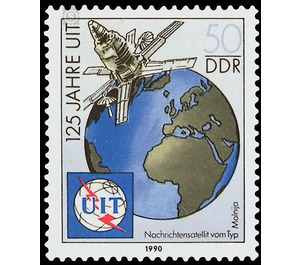128 years - Germany / German Democratic Republic 1990 - 50 Pfennig
Theme: Astronomy & Space
| Country | Germany / German Democratic Republic |
| Issue Date | 1990 |
| Face Value | 50.00 |
| Color | multi-colored |
| Perforation | K 14 |
| Printing Type | offset |
| Stamp Type | Postage stamp |
| Item Type | Stamp |
| Chronological Issue Number | 3077 |
| Chronological Chapter | GER-DDR |
| SID | 559789 |
| In 11 Wishlists | |
125 years of UIT On the occasion of the 125th anniversary of the International Telecommunications Union (Union Internationale télécommunications - UIT), the Ministry of Posts and Telecommunications of the German Democratic Republic issues four multi-color special postage stamps and one block. Special cancellation from 15 May to 14 July 1990 125 years of UIT The International Telecommunications Union - Union internationale des télécommunications (UIT) - is the oldest and largest international organization. Founded on May 17, 1865, as an International Telegraph Union, UIT was granted special UN status in 1947 by a treaty with the United Nations under Article 57 of the UN Charter. The UIT currently comprises 166 member states; the GDR joined the telecommunications association on April 3, 1973 at. The fundamental goal of the UIT is to promote international cooperation and to develop suggestions for the improvement of all types of telecommunication. For this purpose, the Telecommunications Union shall harmonize international law on participation in international telecommunications, adopt operational, legal and charging regulations and technical standards, prepare the introduction of new services (such as telecopying over the telephone network) and use of space for the purposes of Telecommunications promoted. The stamp series gives an overview of significant stages of the technical development of telecommunications. 50-pfennig value: Molnija news satellite in front of the globe For direct reception in remote areas or between the continents, communications satellites are used for both telecommunications, radio and television. They serve, such as. As the Soviet communications satellite Molnija, as a relay station in which the signals received in a straight line are received and amplified. With the use of communications satellites, the final merger of wireline communications with wireless communications is becoming one-to-one telecommunications.


